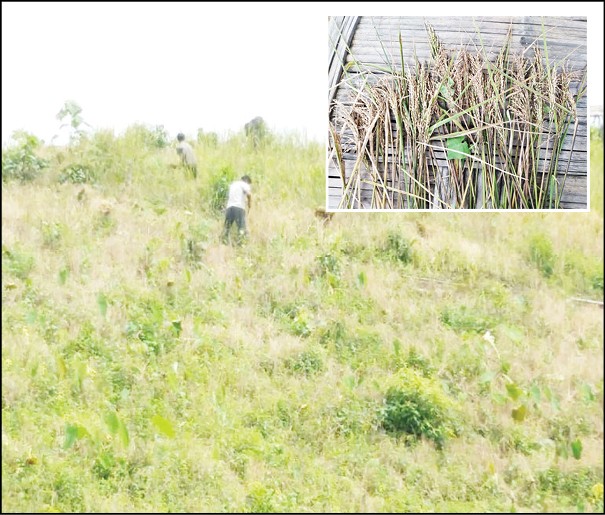Farmers are seen harvesting Jhum rice at a field in Aboi sub-division on August 26. With deficient rainfall, farmers maintain that they are seeing huge reduction of farm yield this season. (Inset) Due to poor season, rice spikelets are relatively lesser resulting in poor harvest. (Morung Photo: By special arrangement)

Moa Jamir
Dimapur | August 26
On June 17, the Department of Agriculture (DoA) Nagaland informed that the State is witnessing a “drought-like situation” due to deficient and erratic rains from December 2020 to April 2021.
With at least 70% of the State’s farmers involved in Jhum cultivation, agriculture and horticulture crops has been adversely affected, as informed during a press conference addressed, among others, by Minister for Agriculture and Cooperation G Kaito Aye and Advisor, Horticulture & Border Affairs Advisor Mhathung Yanthan.
Over two months later, farmers, particularly Jhum cultivators are reporting lower yield of rice, the staple food in Nagaland as well as other crops. For Terrace Rice cultivation (TRC)/Wet Rice Cultivation (WRC), a season was ‘lost’ while they are staring at an uncertain next season.
In this two-part series, The Morung Express looks at the impact of deficient rainfall on farmers and water table. The responses from the State government so far have been presented alongside.
How deficient?
In Indian Metrological Department’s (IMD) classification, rainfall up to -59% to -20% is considered deficient; normal (-19% to 19%); Large Deficient (99% to -60%) Excess (20% to 59%) and ‘Large Excess’ (60% or more).
During the press conference, citing Nagaland State Disaster Management Authority Data (NSDMA), the DoA informed that till May 2021, except in Longleng, Mokokchung and Mon, all other districts had deficient rainfall.
As the South West Monsoon (SWM), normally considered as June 1 to September 30 period, enters the last leg, the deficiency is yet to be improved.
As per the latest IMD data, from June 1 till August 26, Nagaland recorded -24% departure from normal rainfall, with the State receiving only 662 millimetres (mm) against normal rainfall of 875.3 mm.
Accordingly, only four districts - Kiphire (6%), Peren (-1), Mon (-13), Mokokchung (-15) are shown to be having ‘normal’ rainfall, while it is deficient in the rest.
Dimapur was on the verge of being classified as ‘Large Deficient’ at -55% till August 26, followed by Kohima (-41%), Tuensang (-37%), Longleng (-35%), Wokha (-26%), Phek (-25%), and Zunheboto (-22%).
In reply to a query in the Lok Sabha on August 6, the Minister of State (Independent Charge) for Ministry of Science and Technology and Earth Sciences Dr Jitendra Singh, citing IMD Pune’s ‘Analysis of observed monsoon rainfall variability and changes’, informed that five states viz., Uttar Pradesh, Bihar, West Bengal, Meghalaya and Nagaland have shown significant decreasing trends in SWM rainfall during the recent 30 years period (1989-2018).
The State had earlier declared a ‘drought-like situation’ in 2012 and 2009.
Low yield; uncertain future
Even in districts showing ‘normal’ rainfall, the erratic precipitation has had a huge impact. As harvest season begins, most farmers are seeing significantly lower yield.
“I collected just 20-30 baskets (a local measuring method), against normal yield of around 80 baskets on my field,” informed Khamnyei of Langmeing village Aboi Area, under Mon District.
Those fields yielding 30-40 baskets are also harvesting mere 10-15 baskets, he said, implying an average decline of over 50%.
Among others, he maintained that deficient rainfall ‘burned’ rice plants and resulted in poor germination while diseases increased.
Out of around 150 households, 100-120 may be adversely affected and 20-30 are slightly affected, he added, worrying about possible food shortage before the next harvest.
“Maybe cyclones in other part of the world have pulled away the rain from us,” he opined.
“Pani bhal para gira nai” (There was lack of proper rainfall), was the prompt response from Ngamwang Konyak, also from Choha Chingnyu Village under Aboi sub-division.
Even the yield of relative drought resistant millet production has been affected, he said.
Many parts of many fields had to be abandoned midway due to dryness resulting in poor yield, Ngamwang said.
It was double impact for both as other crops planted along with rice such as maize, beans; chilies, etc also suffered a similar fate.
The problem is not restricted to Jhum cultivators alone.
For many TRC and WRC, a cycle of plantation was lost with no rainfall in the first quarter.
“We could manage to cultivate only 70% of the field despite our best effort,” informed Thuputhiyi Venuh, a resident of Phek village, adding that the situation is more or less similar in surrounding villages, and even in Pfutsero and Meluri sub-division.
‘Sukha ase,” (It’s dry), said Kedezu, a worried farmer from Bade village under Dhansiripar Block, Dimapur.
Just yesterday, I had to draw water using dam, he said, unsure about how many times he has to resort to such measures to do his plantation.
This has significantly increased his input cost with over Rs 20,000 extra cost for water due to water scarcity so far.
He further estimated that around 60% of his villagers, situated near the Dhansiri River, have been affected.
No relief so far
All the farmers approached by this newspaper informed that they were yet to receive any direct relief from the State government.
Two months ago, we were promised some relief in the form of rice but we are yet to receive it, informed Kedezu.
Meanwhile, Ngamwang said that the Agriculture office at Aboi has asked for names of affected farmers on Wednesday and that he submitted around 70-80 names on Thursday.
Some months back, the government had promised to supply new saplings in August or September and we are hopefully waiting for the same, informed Venuh, who is the Chief coordinator, Phek Farmer’s Club.
My earnest request to the Agri and Allied Department is to undertake spot verification of the affected fields to ensure that genuine farmers are benefited as and when provided, he appealed.
Meanwhile, after the press conference, the DoA in a presentation titled ‘Drought-Like Situation: Deficient Rainfall 2021’ dated July 15, highlighted various impacts, measures undertaken as well as advisories. (See box) A ‘district-wise crop calendar’ was also released on July 27.
Queries to DoA on August 26 indicated that the department is still assessing magnitude of the impact of ‘drought-like’ situation and yet to provide any direct relief so far and the July 15 presentation is still the standing status.
“The Department is yet to receive data and status from the districts and subdivisions of recent field situation which will take time as they are to take stock and verify from the farmers and villages affected,” a DoA official stated.
(This is the first of a two-part series.)
Impact
• The ‘drought-like situation’ has resulted in acute water scarcity and has directly resulted in poor germination and wilting of crops and 72,664 hectares (Ha) of jhum fields covering 915 villages are affected.
• Water scarcity indirectly resulted in Fall Armyworm (FAW) infestation in maize from last week of March and 3048.45 ha and 334 villages were affected.
• The water scarcity also resulted in poor quality of harvested products and reduced productivity while delaying land preparation and sowing of the Terrace Rice cultivation (TRC)/Wet Rice Cultivation (WRC).
DoA Interventions
• Change in crop sequence/cropping system & varietal replacement.
• Re-sowing or gap filling for poor germinated Jhum.
• Local land races for Jhum paddy & maize intercropped with legumes (soybean), oil seeds (sesame).
• Short to Medium duration varieties for TRC paddy in uplands.
• Late sowing variety for W/TRC in valleys and plains.
• Compensatory crop like soybean/mung/black gram etc if monsoon is further delayed.
• Mulching with local bio-mass through-out the cropping period for in situ moisture conservation.
• Summer ploughing, construction of check dams, compartmental bunding and RWH (farm pond).
• ‘District-wise crop calendar’ released on July 27.
(Source: DoA, Nagaland)
Read Related Reports:
Amid deficient rainfall, Nagaland’s sole water reservoir below ‘normal’ storage
DEFICIENT RAINFALL IN NAGALAND-II: Possibility of water ‘scarcity’ high in winter





.jpg)
